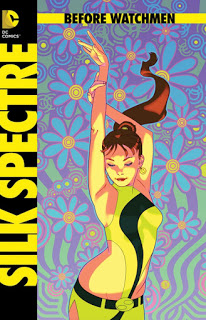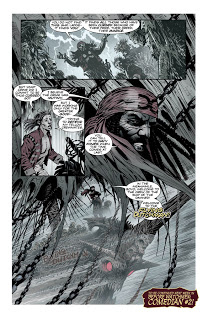 |
| Joshua Middleton variant cover |
Darwyn Cooke & Amanda Conner‘s SILK SPECTRE #2 trips headlong into the id of the psychedelic 60s via a sinister plot right out of… Josie and the Pussycats?
While not as strong as the debut issue in relaying Laurie’s inner monologue, there’s a playful use of irony in which the visuals conflict with the narration (something that would have benefited OZYMANDIAS greatly). Conner’s artwork is as expressive as ever and Cooke has abandoned the incidental song lyrics that served little purpose in issue number one, so this second volume of SILK SPECTRE stays the course as the plot gets a little more far out. In other words, it’s a resounding sequential success for the Before Watchmen line, which has had little else to champion thus far.
The Pussycat reference is not hyperbole. In the heart of Haight-Ashbury, dark forces are manipulating the love generation via programmed narcotics that subliminally encourage rabid consumption. If that sounds familiar, it’s because this is a similar conspiracy to the one addressed in the Josie and the Pussycats film from 2001. Cooke has expanded the theme of compromised-integrity-on-the-road-to-commercial-success into a veritable indictment of the consequence of selling out as a culture (as opposed to just going Hollywood). If the Hippies were compromised in their later incarnation as Yuppies, this narrative serves up a scathing social critique (albeit, a heavy-handed one) of misguided idealism. Whether or not this reflects the writer’s feelings about either the Occupy Movement or the Tea Party is for him to say, but it’s easy to draw parallels between the subjugation of the 60s Peaceniks and the recent overthrow of grassroots movements on the right and left of today’s political landscape. Some might even conjecture that Cooke has served up a thinly veiled mea culpa for his own participation in DC’s crass commercialization of the original WATCHMEN series. Whichever way you take it, his message is not delivered as a sermon, but as satire in the Swiftian vein.
Amanda’s colorful pencils appear in direct contrast to the dark motives at work behind the scenes at the Sand Doze nightclub, and this is a juxtaposition that works. Her classic nine-panel layout lends a certain sobriety to this tale of sex, drugs and rock ‘n roll that never sinks to cheap exploitation even though Laurie is presented as a minor when she leaves town with her high-school boyfriend. In other words, all the sex and partial nudity presented in this comic is actually between two, underage characters, so while it isn’t cheap, it is technically exploitation.
 The artwork in the ongoing backup story, Curse of the Crimson Corsair, has been getting progressively better, but as such is getting further and further away from the look of a classic EC PIRACY comic. Joe Orlando‘s Tales of the Black Freighter in the original WATCHMEN was pitch perfect because Orlando had actually worked at EC. John Higgins‘ pencils are far more reminiscent of his 80s contemporaries Stan Woch, Steve Bissette and John Tottleben, which is fine, but anachronistic. The plot continues to meander, but in two-page installments, what else can be expected? In point of fact, we’ve never been told that this new swashbuckling, gore story is supposed to be from any specific era, so any criticism of how contemporary looking the art is or isn’t may be moot. But the line is called Before Watchmen, so speculating that the backup story should match the era presented in the imprint in which it appears is valid. Of course, if a sub-genre of popular comic books based on EC’s PIRACY had proven incredibly influential, it is possible that Ghastly Graham Ingels might have had the impact on pirate and horror comic illustrators that Jack Kirby had on superhero pencilers. Higgins’ graphic and gruesome style might represent a natural evolution of the prevailing look of those earlier comics –just as Bernie Wrightson and Richard Corben were doing comics in the late 60s and early 70s that channeled Ingels’ work from the 50s. Len Wein has done a good job of replicating the feel of his early work for Warren Publications like CREEPY and EERIE, so in a way, he is the man for the job today in much the same way that Orlando was the natural choice back in 1987. That may make an argument for authenticity, but it doesn’t make much of a case for quality. Crimson Corsair neither enriches or detracts from the feature, which makes one question its necessity.
The artwork in the ongoing backup story, Curse of the Crimson Corsair, has been getting progressively better, but as such is getting further and further away from the look of a classic EC PIRACY comic. Joe Orlando‘s Tales of the Black Freighter in the original WATCHMEN was pitch perfect because Orlando had actually worked at EC. John Higgins‘ pencils are far more reminiscent of his 80s contemporaries Stan Woch, Steve Bissette and John Tottleben, which is fine, but anachronistic. The plot continues to meander, but in two-page installments, what else can be expected? In point of fact, we’ve never been told that this new swashbuckling, gore story is supposed to be from any specific era, so any criticism of how contemporary looking the art is or isn’t may be moot. But the line is called Before Watchmen, so speculating that the backup story should match the era presented in the imprint in which it appears is valid. Of course, if a sub-genre of popular comic books based on EC’s PIRACY had proven incredibly influential, it is possible that Ghastly Graham Ingels might have had the impact on pirate and horror comic illustrators that Jack Kirby had on superhero pencilers. Higgins’ graphic and gruesome style might represent a natural evolution of the prevailing look of those earlier comics –just as Bernie Wrightson and Richard Corben were doing comics in the late 60s and early 70s that channeled Ingels’ work from the 50s. Len Wein has done a good job of replicating the feel of his early work for Warren Publications like CREEPY and EERIE, so in a way, he is the man for the job today in much the same way that Orlando was the natural choice back in 1987. That may make an argument for authenticity, but it doesn’t make much of a case for quality. Crimson Corsair neither enriches or detracts from the feature, which makes one question its necessity.